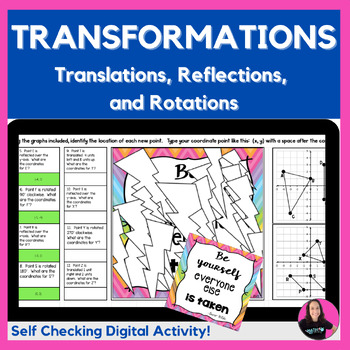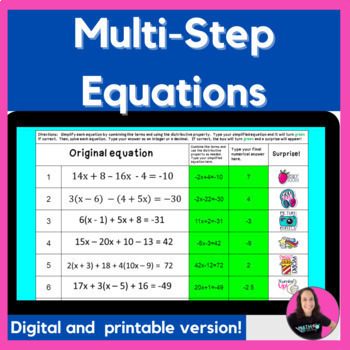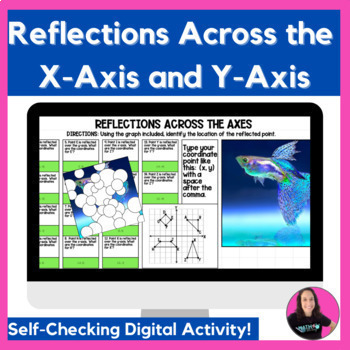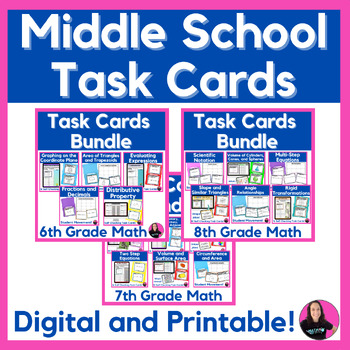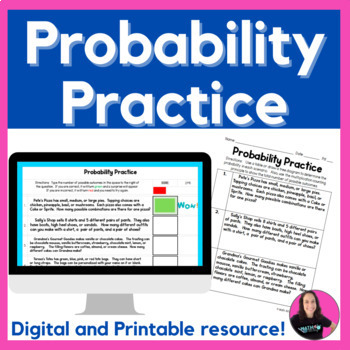Teaching middle school is no easy task. Teaching middle school math however can seem almost impossible to some (not me, but some). What if, on top of the middle school years being challenging behaviorally, emotionally, and academically, I told you that seventh grade is one of the most important years for students? In 7th grade, they enter the world of ratios and proportional relationships. Concepts like unit rate, percent increase, and equivalent ratios are like the foundation for more advanced topics such as algebraic expressions and linear functions. However, making these ideas stick with 7th grade students can be challenging.
Why Math Worksheets Are Essential
In this day and age, printable worksheets seem to have been replaced by technology. Don’t get me wrong; I love using technology well. However, worksheets or task cards are often underestimated.
They can be helpful tools for teaching seventh grade math ratios and proportional relationships. Here’s why they’re so effective:
Build Vocabulary: Students need repeated exposure to terms like scale factor, coordinate plane, and double number lines to develop a solid understanding of ratios and related concepts. Worksheets provide this repetition in a structured way.
Visual Aids: Visual learners benefit from tools like graphs of proportional relationships and number line examples, helping them make sense of abstract ideas.
Real-Life Applications: Worksheets can include scenarios such as calculating sales tax, unit price, and simple interest to make math relatable by connecting it to everyday life.
Activities for Ratios and Proportional Relationships
Teaching ratios and proportional relationships don’t have to be the same old drill over and over. I love throwing in some fun, creative activities alongside worksheets that can spice things up and make the lessons way more exciting (and memorable) for everyone. I’ll tell you about my absolute favorite ratios and proportional relationships 7th grade worksheets at the bottom of this list!
Mystery Picture Challenges: Students solve problems to reveal a hidden image, adding an element of fun while practicing proportion word problems or other mathematical concepts.
Real-World Projects: Assign projects where students calculate percent increase, simple interest, or unit price for items in a pretend store. These tasks make math applicable to their daily lives.
Graphing Activities: Have students plot points on a coordinate plane to understand the meaning of a proportional relationship graph. These hands-on tasks build connections between visual and numerical representations.
Error Analysis: Use error analysis as a collaborative activity. Have students work in groups to identify and fix errors in problems involving ratios of fractions or terms of the situation. Encourage them to explain their reasoning and discuss different approaches as they find the correct solutions.
The Power of Error Analysis Worksheets
Error analysis is my secret weapon for helping students grasp ratios and proportional relationships. Digging into mistakes doesn’t just show them how to fix them—it helps them understand why the mistakes happened in the first place.
Here’s how you can integrate error analysis into your lessons:
Provide Examples of Mistakes
Use worksheets that include intentional errors or have students analyze completed problems. For instance, a student might incorrectly calculate a unit rate or graph a straight line without considering the constant value times.
Encourage Critical Thinking
Ask students to identify errors, explain them, and find solutions. This process sharpens their understanding of mathematical concepts and helps them avoid similar mistakes in the future.
Collaborate and Discuss
Group activities focused on error analysis allow students to share different problem-solving methods and learn from each other. Group discussion is also a great way for students to see how their peers solve problems. This gives them a fantastic opportunity to learn not just from you but from the students around them.
Connect to Real-Life Scenarios
Highlight how these errors can translate to real-world consequences, like overpaying due to an incorrect unit price or misinterpreting a proportion in a recipe. One great thing about being a math teacher right now is the shift toward “real-life problems.” Johnny no longer buys 1,345 donuts to eat after dinner!
How Worksheets Can Transform Learning
High-quality worksheets designed for seventh grade ratio problems and proportional relationships can make a massive difference in student understanding. These resources cover many topics, from basic operations to the number system and even converting fractions. Worksheets can help reinforce skills like identifying the independent variable or solving proportion word problems. With answer keys included, teachers and students can easily track progress.
Whether your students are revisiting 6th grade concepts, exploring connections to 5th grade or earlier math skills, or tackling advanced seventh grade challenges, worksheets provide the structure and flexibility needed to succeed. Pairing these resources with error analysis and real-life examples makes the learning experience even more impactful.
Stay Connected for More Resources
Are you looking for more ways to engage your students with ratios and proportional relationships? Sign up for my newsletter and receive math teacher tips, giveaways, exclusive free worksheets, and more! Plus, I will send you my favorite error analysis activity for Ratios and Proportional Relationships.



.PNG)





